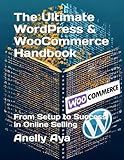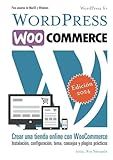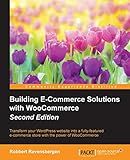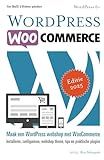Best WooCommerce Tools to Buy in October 2025

The Ultimate WordPress & WooCommerce Handbook: From Setup to Success in Online Selling



WordPress WooCommerce: Tienda online con WooCommerce (Spanish Edition)



Building E-Commerce Solutions with WooCommerce - Second Edition



WordPress WooCommerce: Webshop met WooCommerce (Dutch Edition)



Formation Woocommerce: Créer et exploiter une boutique en ligne (French Edition)



Setting Up and Running an Online Store


To translate the WooCommerce checkout page, you need to follow these steps:
- Install a translation plugin: Start by installing and activating a translation plugin like WPML (WordPress Multilingual) or Polylang. These plugins allow you to create translations for various elements on your website, including the checkout page.
- Configure the translation settings: Once you have installed the translation plugin, go to its settings page. Configure the necessary settings according to your language preference, including the default language and available languages.
- Access the translation interface: After configuring the settings, navigate to the translation interface of the plugin. This interface allows you to create and manage translations for different parts of your website.
- Select the checkout page for translation: Locate the WooCommerce checkout page in the translation interface. It is usually listed as one of the pages that can be translated. The exact location may vary depending on the translation plugin you are using.
- Create translations for checkout elements: Within the translation interface, you will find various elements specific to the WooCommerce checkout page. These elements include text strings like button labels, field names, and error messages. Translate these elements one by one, providing the equivalent text in your target language.
- Save and apply translations: Once you have translated all the necessary elements on the checkout page, save the translations. The translation plugin will automatically apply them to the respective language versions of your checkout page based on the user's language selection.
- Test and refine translations: Finally, test the translated checkout page to ensure that all translations are accurate and properly applied. If you notice any errors or inconsistencies, go back to the translation interface and make the necessary adjustments.
By following these steps, you can effectively translate the WooCommerce checkout page and provide a seamless shopping experience for users in different languages.
Is it possible to translate the "Place Order" button on the checkout page?
Yes, it is possible to translate the "Place Order" button on the checkout page. The process may vary depending on the specific platform or software being used for the checkout page. However, most platforms provide localization or internationalization features that allow you to customize and translate various elements, including buttons, labels, and messages, into different languages. You can consult the documentation or settings of your checkout page platform to find out how to translate the button.
How can I access the WooCommerce checkout page for translation?
To access the WooCommerce checkout page for translation, you can follow these steps:
- Install and activate a translation plugin: There are several popular translation plugins available for WordPress, such as WPML (https://wpml.org/) or Polylang (https://polylang.pro/). Choose and install a suitable plugin that supports WooCommerce translations.
- Configure the translation plugin: Once the translation plugin is installed, go to its settings page and configure it according to your language requirements. Set your default language and any additional languages you want to translate the checkout page into.
- Enable translation for WooCommerce checkout: Check if your translation plugin offers WooCommerce integration. In most cases, popular translation plugins have built-in support for WooCommerce. Enable the translation feature for the WooCommerce checkout page.
- Translate the checkout page: After enabling the translation feature, go to the WooCommerce checkout page on your website. Most translation plugins provide a user-friendly interface for managing translations directly from the WordPress admin area. Look for the option to translate pages or strings and start translating the checkout page content into your desired language. Alternatively, you can use a professional translation service and manually input the translated content into the plugin's interface.
- Customize translated elements: Besides translating the text content, you may also need to customize elements like payment options, order fields, or shipping methods on the checkout page to fit the requirements of your target language or region. The translation plugin should provide options to handle these settings as well.
- Review and test translations: Once the translation is complete, review the translated checkout page to ensure accuracy and consistency. Make sure all elements, buttons, and fields are correctly translated. Test the checkout process thoroughly by placing test orders and checking if everything is working as intended.
Remember to regularly update your translation plugin and keep an eye on compatibility with WooCommerce updates to ensure smooth functioning of the translated checkout page.
Can I translate shipping and billing details on the WooCommerce checkout page?
Yes, you can translate the shipping and billing details on the WooCommerce checkout page. Here's how you can do it:
- Install and activate a translation plugin: To translate the WooCommerce checkout page, you will need a translation plugin like WPML (WordPress Multilingual Plugin) or Polylang. Install and activate the translation plugin of your choice.
- Configure the translation plugin: After activating the translation plugin, configure it by following the instructions provided by the plugin. This usually involves selecting the languages you want to translate your website into and setting up language switchers.
- Translate the strings: Once you have configured the translation plugin, go to the plugin settings or the WooCommerce settings and look for the option to translate strings or texts.
- Find the shipping and billing details to translate: In the translation settings, you should be able to search for specific strings or texts to translate. Look for the shipping and billing details strings on the checkout page.
- Translate the strings: Once you have located the strings related to shipping and billing details, you can translate them into the desired language. The translation plugin will provide a text box where you can input the translated text.
- Save the translations: After translating the strings, save the translations, and make sure to update the settings.
- Test the translated checkout page: Finally, visit the WooCommerce checkout page on your website and switch to the translated language to test if the shipping and billing details are displaying correctly in the new language.
Note: The process may vary slightly depending on the translation plugin you choose. It's recommended to refer to the documentation or support resources for the specific translation plugin you are using for more detailed instructions.
Can I translate error messages that appear on the checkout page?
Yes, you can translate error messages that appear on the checkout page. Most e-commerce platforms allow customization of text and language settings, including error messages. Check your platform's documentation or settings to see if there is an option to translate error messages. If not, you may have to customize the code or employ additional language translation tools.
How can I change the checkout page language in WooCommerce?
To change the checkout page language in WooCommerce, you can follow these steps:
- Install and activate a translation plugin: WooCommerce does not provide built-in language translation for the checkout page, so you'll need to use a translation plugin like WPML, Polylang, or Loco Translate.
- Set up your language settings: After installing the translation plugin, configure its settings to your desired language. This can typically be done through the plugin's settings page or in the WordPress admin panel under Settings > Languages.
- Translate the checkout page: Once your language settings are in place, you can translate the checkout page. The translation process will depend on the translation plugin you're using: WPML: Go to WPML > String Translation. Search for the strings related to the checkout page, such as "Billing Details," "Place order," etc. Translate these strings to your desired language. Polylang: Edit the checkout page in the WordPress admin panel, and then switch to the desired language. Modify the content of the page to the corresponding language. You can create different versions of the page for each language. Loco Translate: Go to Loco Translate in the WordPress admin panel, and locate the WooCommerce plugin. Find the strings related to the checkout page, and translate them to your desired language.
- Sync translations: After translating the checkout page, make sure to sync or save the translations using the translation plugin's provided options.
- Check the checkout page: Visit the checkout page on your website to see the changes. It should now display in the language you've translated it to.
By following these steps with a translation plugin, you can change the checkout page language in WooCommerce to match your desired language.
Can I use different languages for different countries on the checkout page?
Yes, it is possible to use different languages for different countries on the checkout page of a website. This approach is referred to as "language localization" or "multilingual support." By implementing language detection based on the user's geographic location, you can display the appropriate language for that country on the checkout page. This is particularly useful for providing a seamless user experience and improving conversion rates for customers from various regions.
Are there any plugins available to help with WooCommerce translation?
Yes, there are several plugins available to help with WooCommerce translation. Some popular ones include:
- WPML (https://wpml.org/) - WPML is a widely-used plugin that allows you to translate your entire WooCommerce store, including products, categories, and other content.
- Polylang (https://polylang.pro/) - Polylang is another popular translation plugin that supports WooCommerce. It allows you to create multilingual WooCommerce stores and easily translate products, categories, and other elements.
- Weglot (https://weglot.com/) - Weglot is a powerful translation plugin that integrates with WooCommerce. It automatically detects and translates your WooCommerce store into multiple languages.
- TranslatePress (https://translatepress.com/) - TranslatePress is a user-friendly translation plugin that supports WooCommerce. It provides an intuitive visual translation interface that allows you to easily translate your store's content.
These plugins offer different features and functionalities, so it's recommended to research and choose the one that best fits your needs and requirements.
